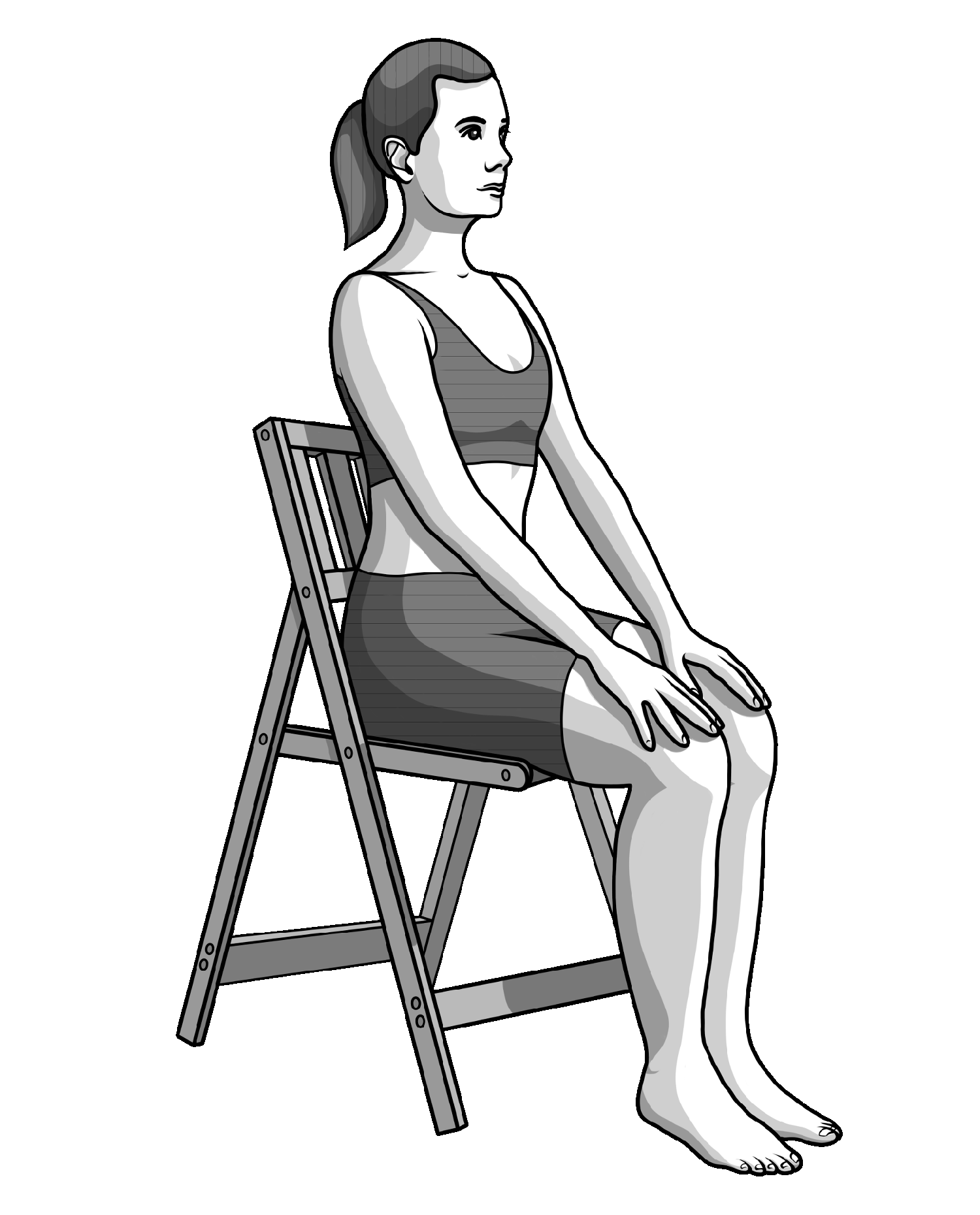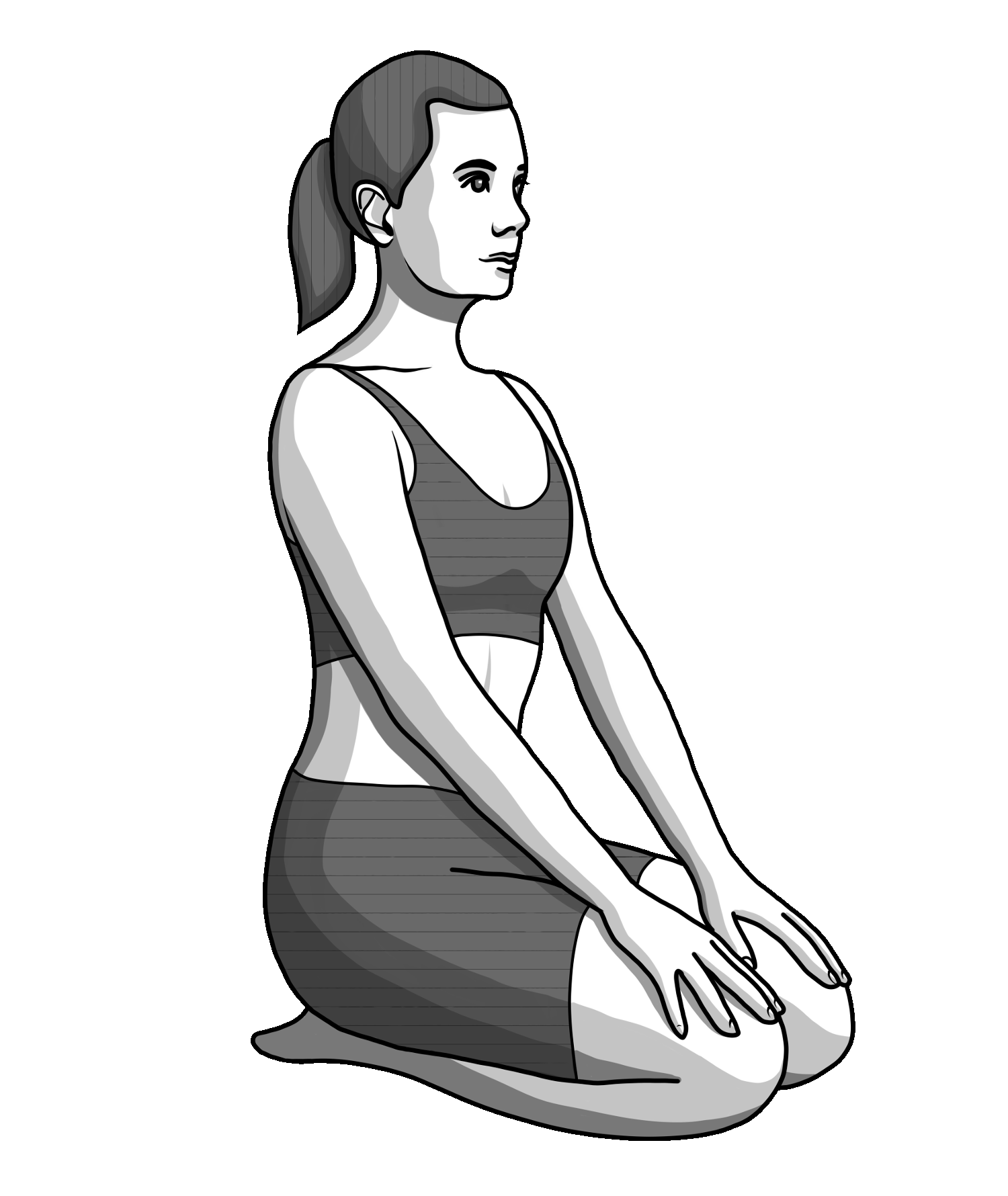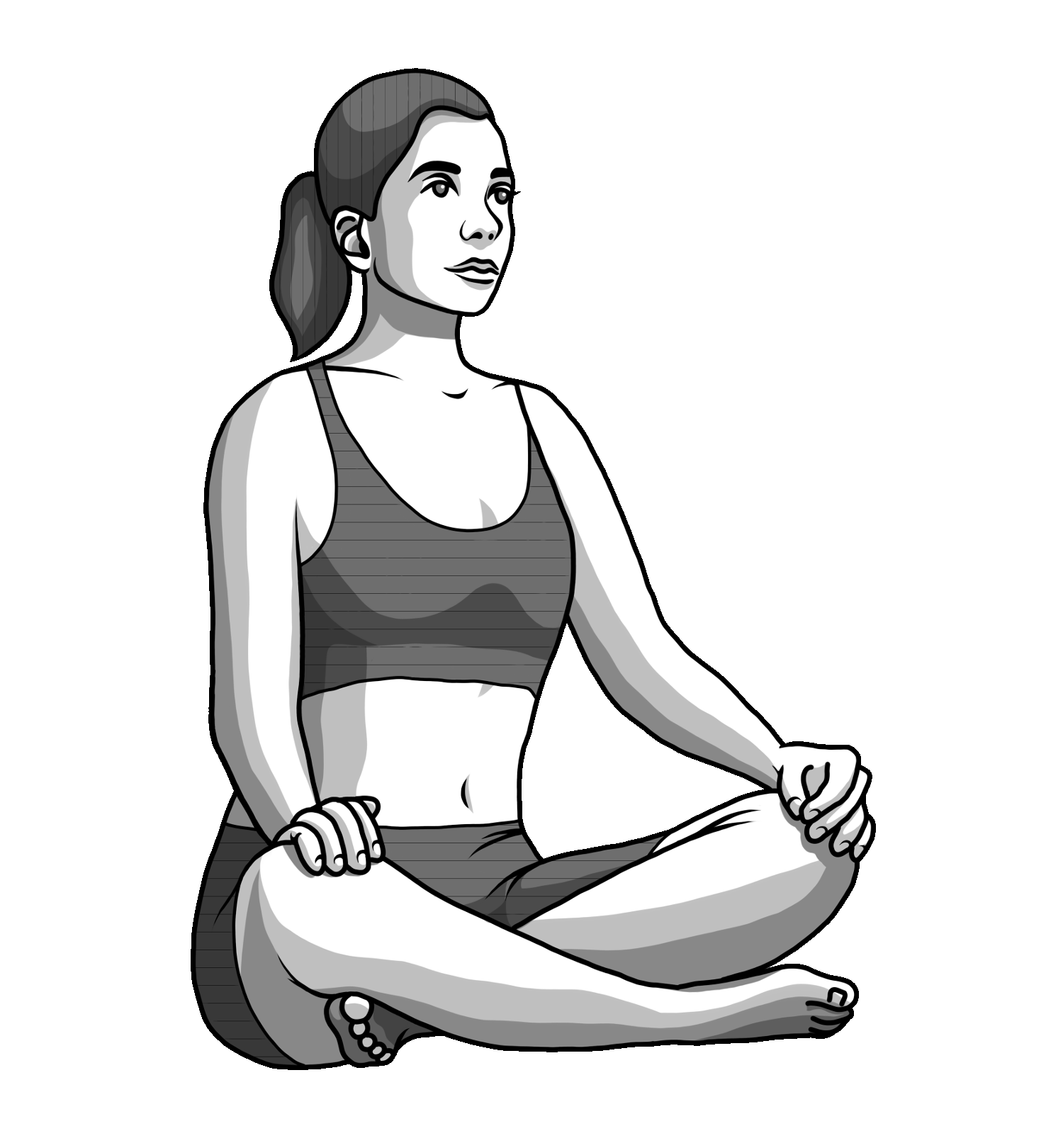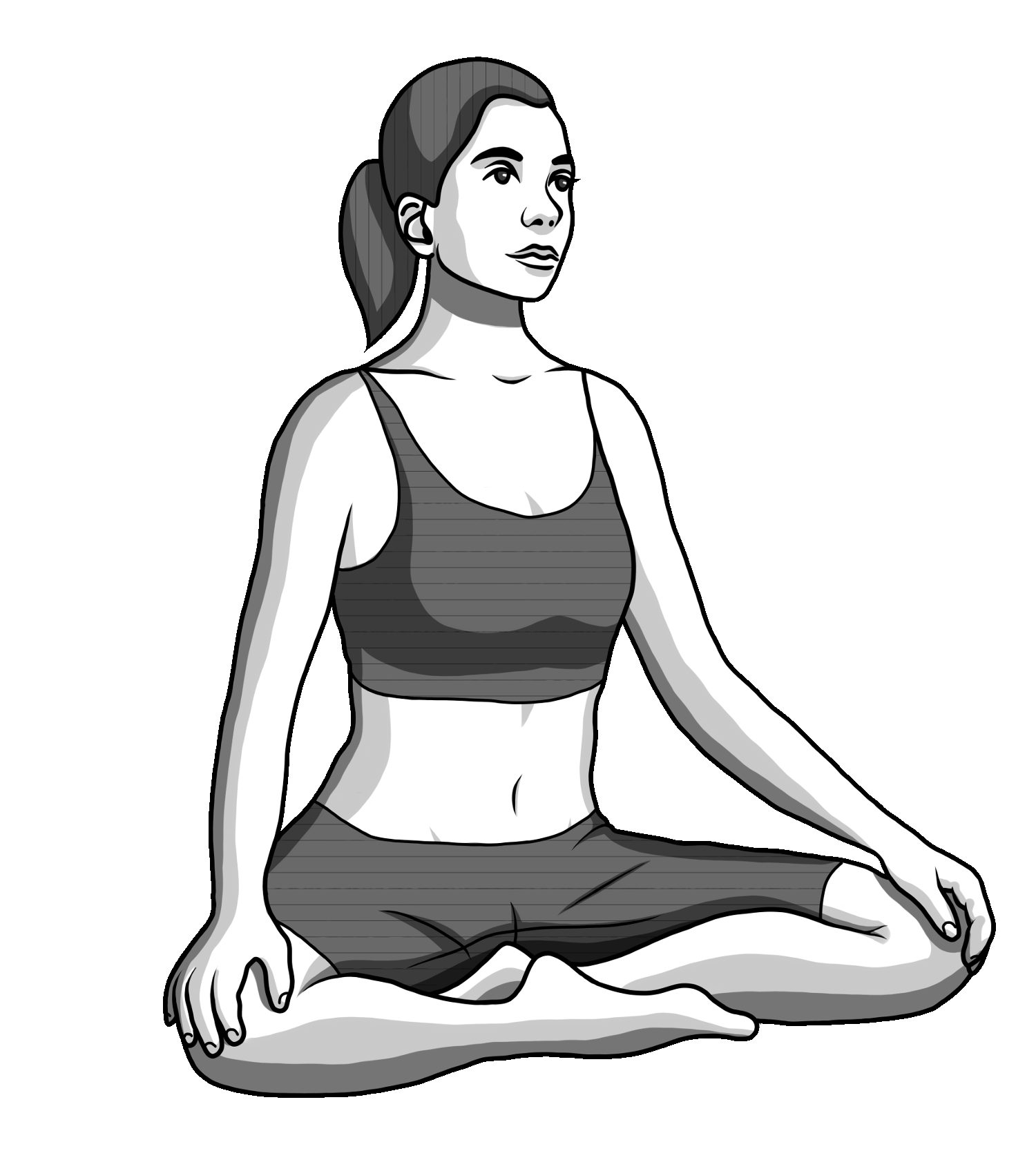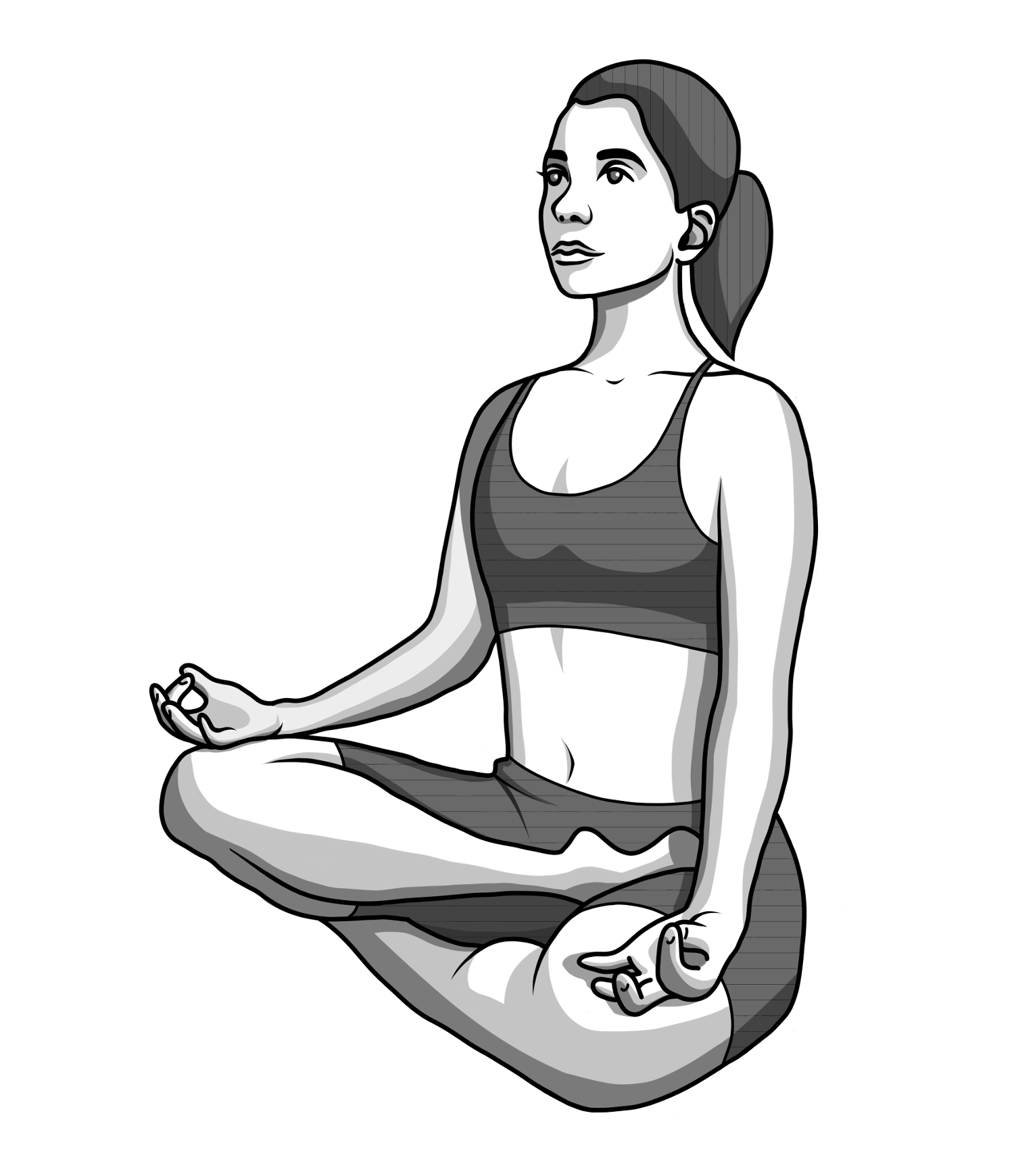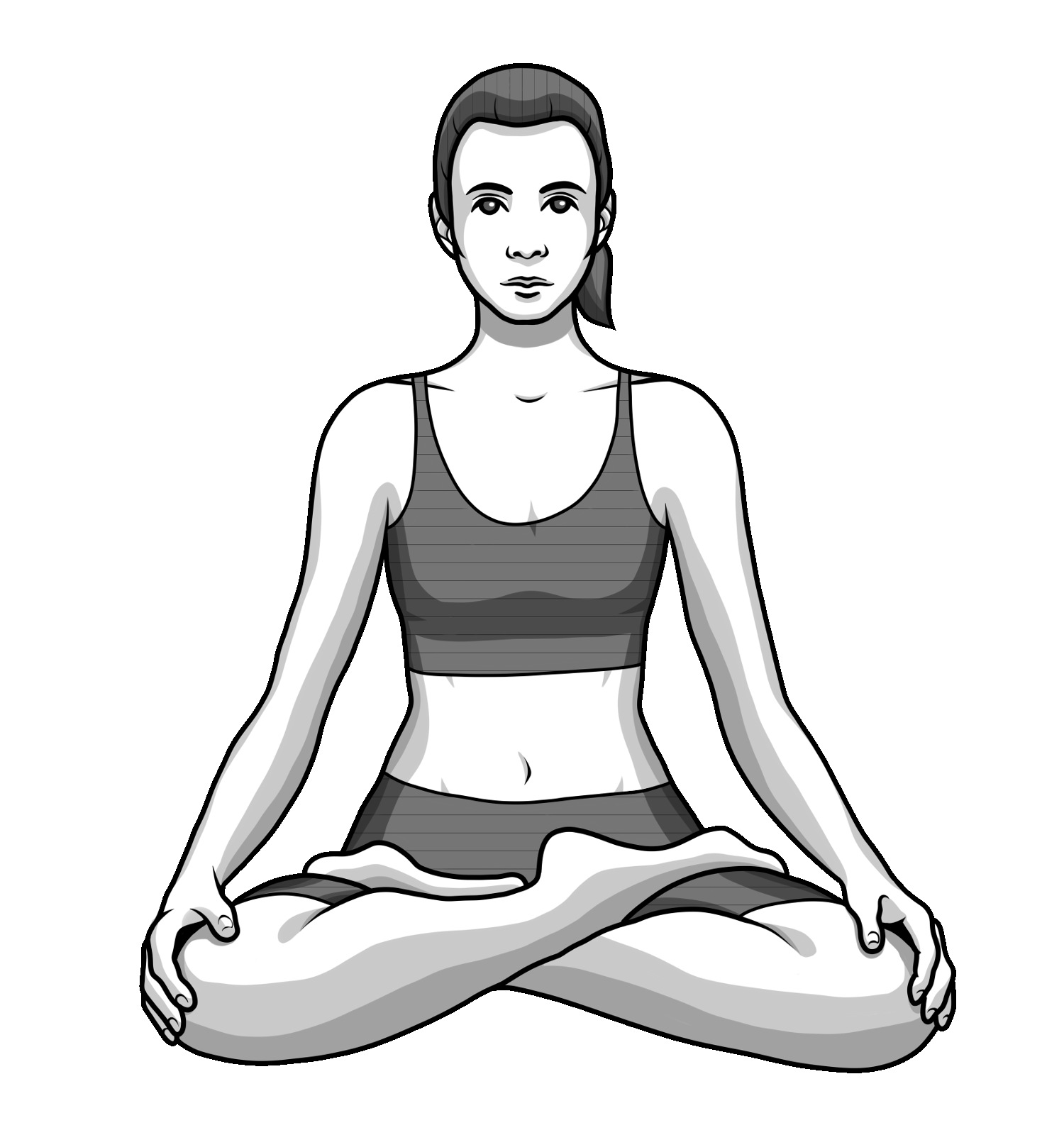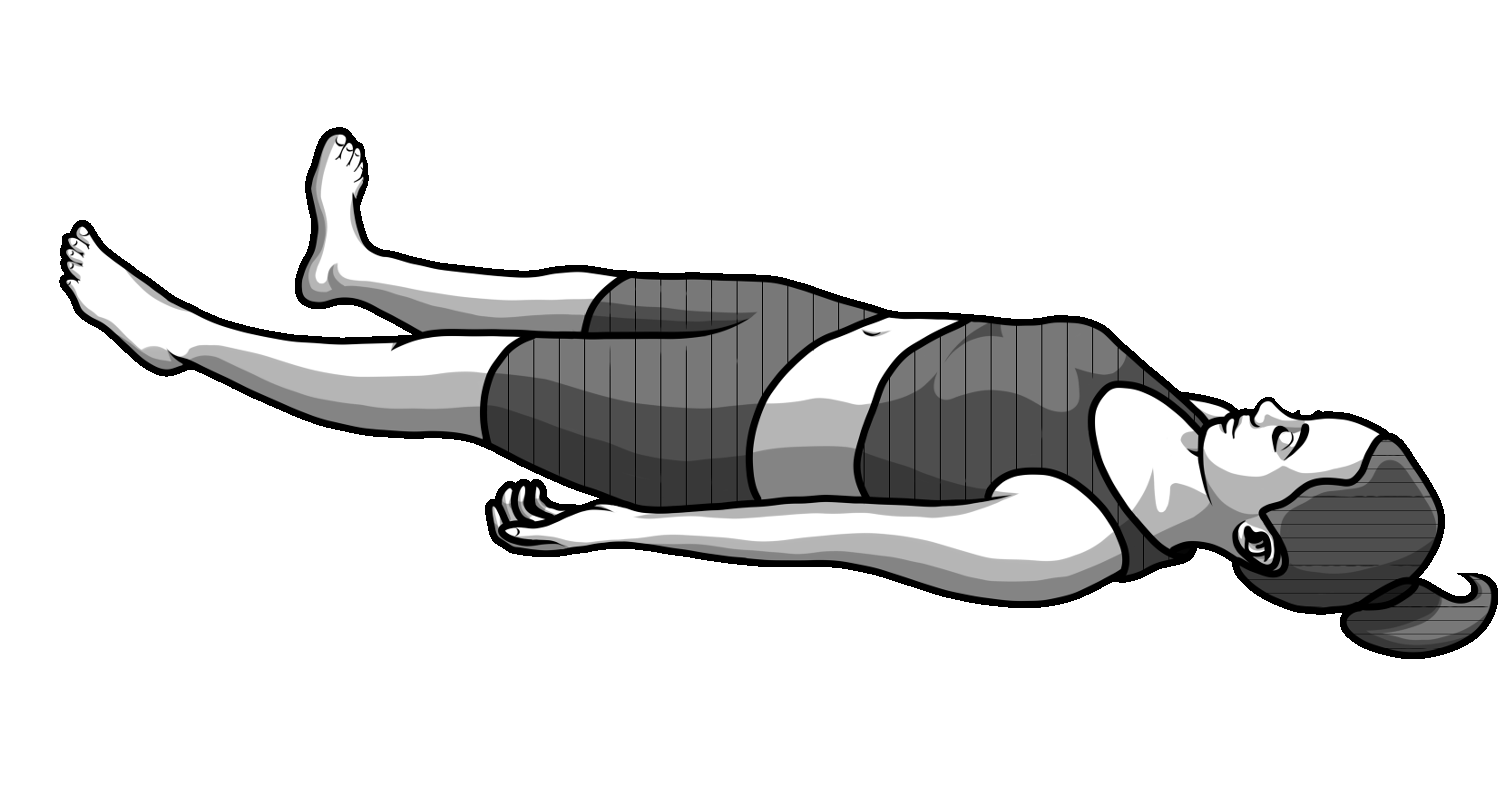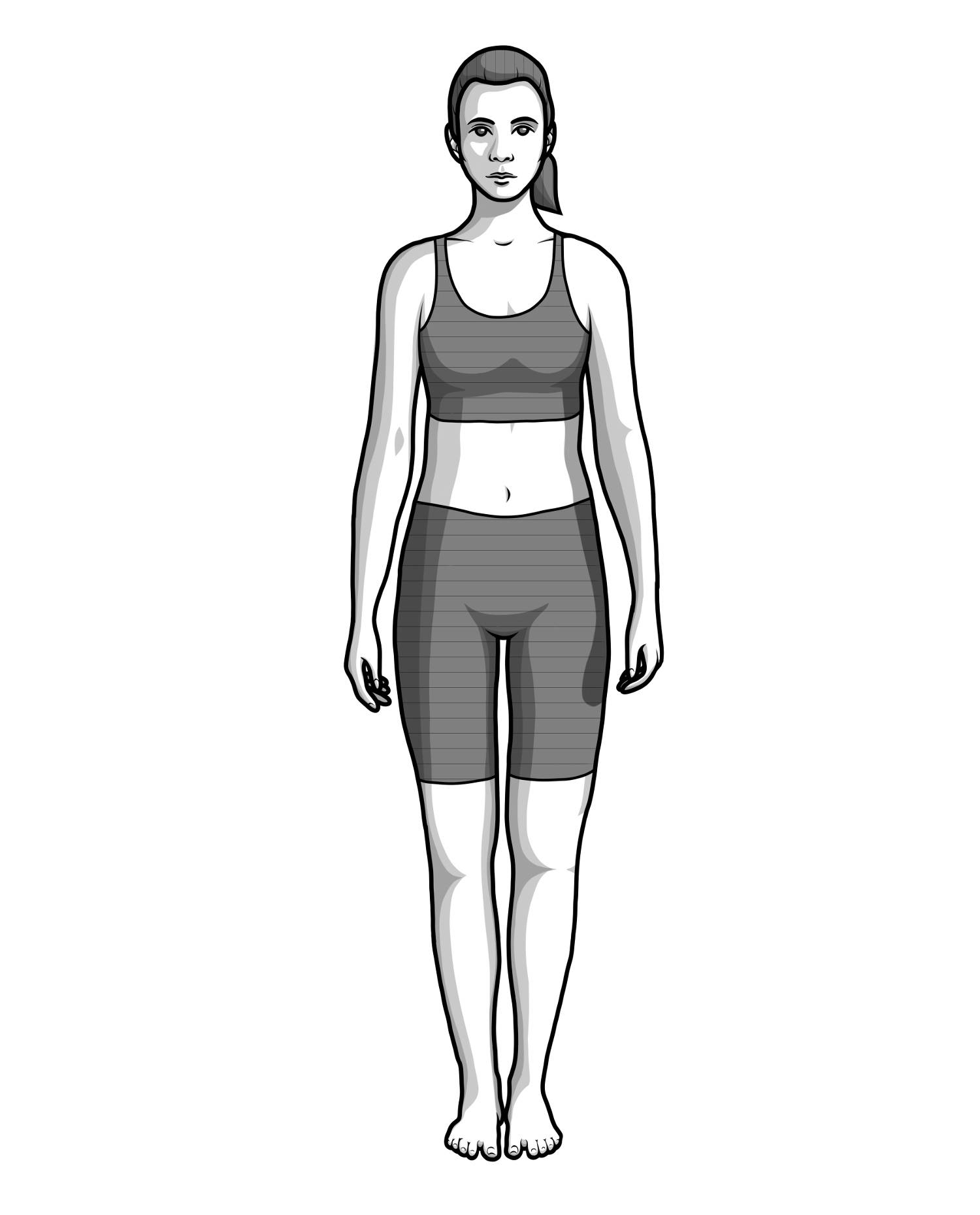Difference between revisions of "Comfortable position/en"
(Updating to match new version of source page) |
(Updating to match new version of source page) |
||
| (One intermediate revision by the same user not shown) | |||
| Line 1: | Line 1: | ||
| − | You may choose any of the following positions as long as you are comfortable with | + | You may choose any of the following positions as long as you are comfortable with it and can keep your posture straight till the end of your [[Special:MyLanguage/breathing gymnastics|breathing gymnastics]] session. |
== Sitting == | == Sitting == | ||
| − | Any straight back position works | + | Any straight back position works, as long as it feels comfortable for you. Here is the list of most popular ways of sitting for breathing gymnastics or meditation. |
| + | |||
| + | === On a chair === | ||
| + | You sit on a chair so your feet are flat on the floor and your knees are in line (or slightly lower) with your hips. Adjust the chair height if needed. Keep your hips far back in the chair, your back straight and your chin high. Your arms rest on your laps. | ||
| + | <div class="responsive-img"> | ||
| + | [[File:chair_pos.png|center]] | ||
| + | </div> | ||
| + | |||
| + | === On your heels === | ||
| + | Rest your buttocks on the soles of your feet, with your feet and thighs touching. Untuck your toes and press the tops of your feet firmly and evenly along the floor. Keep your back straight, trying to be as tall as possible. You arms rest on your laps. Do not bend your head. | ||
| + | * You may put a folded blanket beneath your legs to feel more comfortable. | ||
| + | * This position is named ''Vajrasana'' in Sanskrit, meaning "Adamant pose" or "Thunderbolt pose". | ||
| + | * If your feet are separated and the buttocks are on the floor, it is ''Virasana'', or "Hero pose". You may also use it if it feels comfortable for breathing gymnastics. | ||
| + | <div class="responsive-img"> | ||
| + | [[File:vajrasana_pos.png|center]] | ||
| + | </div> | ||
| + | |||
| + | === Simple crossed leg position === | ||
| + | Sit down on a floor on on a Yoga mat. Make sure your spine is straight and aligned with the head and neck. Cross your shins, widen your knees, and slip each foot beneath the opposite knee as you bend your knees and fold the legs in toward your torso. Your arms rest on your laps. | ||
| + | * In Sanskrit, this body position is called ''Sukhasana'', meaning "Comfortable pose", or "Pleasure pose". It is not a stable pose, as you can slouch easily, but it is a good solution for the people with knee problems, or for short training sessions. | ||
| + | * For all crossed leg positions, it is a good idea to start mastering them with folded blankets or cushions for some extra support. | ||
| + | <div class="responsive-img"> | ||
| + | [[File:sukhasana_pos.png|center]] | ||
| + | </div> | ||
| + | |||
| + | === Crossed leg position === | ||
| + | Sit straight with your feet close in to the perineum but resting on the ground. Your ankles are not crossed. You try to look as tall as possible, meaning your spine is erect. Your arms rest on your thighs. | ||
| + | * This position is called ''Muktasana'' in Sanskrit, meaning "Liberation pose", or ''Ardha Siddhasana'' ("Half-accomplished pose"). It is a simplified version of ''Siddhasana'' ("Accomplished pose"), yet it is quite stable and easy to stay in for a long time. | ||
| + | * In ''Siddhasana'', ankle bones are touching and the heels are above one another with the top heel pressing the pubis directly above the genitals. This position is claimed to foster the powers or siddhis to the yogi who practices it daily for 12 years (by Iengar). | ||
| + | * If you tuck the toes of your top leg between the calf and thigh muscles of your bottom leg, it is another crossed leg position called ''Swastikasana'' ("Auspicious pose"). It is the first of 84 asanas described and illustrated in [https://en.wikipedia.org/wiki/Joga_Prad%C4%ABpik%C4%81 Jogapradipika]. | ||
| + | <div class="responsive-img"> | ||
| + | [[File:siddhasana_pos.png|center]] | ||
| + | </div> | ||
| + | |||
| + | === Half lotus === | ||
| + | Take a simple crossed leg position. Then leave one leg bent and resting on the ground, and put the other foot on top of the opposite thigh with its sole facing upward and heel as close to the abdomen as possible. Again, your body position is straight and your arms rest on your thighs or laps. | ||
| + | * In Sanskrit it is called ''Ardha Padmasana'' - "Half lotus pose". It is a simplified version of "Lotus pose", yet it is quite stable. Some teachers state this position is no less powerful than the "true lotus". | ||
| + | <div class="responsive-img"> | ||
| + | [[File:ardha_padmasana_pos.png|center]] | ||
| + | </div> | ||
| + | |||
| + | === True lotus === | ||
| + | Take a simple crossed leg position. Put one foot on top of the opposite thigh with its sole facing upward and heel close to the abdomen, and the other foot - on the opposite thigh as symmetrically as possible. You may use a folded blanket or a cushion for your knees to feel more comfortable, especially if you are new to this position. Your arms rest on your laps. | ||
| + | * In Sanskrit it is named ''Padmasana'', the "Lotus pose", and is considered as one of the most stable and powerful poses for Pranayama. | ||
| + | * A figure seated in lotus position on a lotus flower is shown on dinar coins of the emperor Chandragupta II, who reigned c. 380–c. 415 AD. | ||
| + | <div class="responsive-img"> | ||
| + | [[File:padmasana_pos.png|center]] | ||
| + | </div> | ||
== Lying == | == Lying == | ||
| − | + | Laying down in a relaxed way is a good choice if you are unable to maintain a straight back position during the whole breathing session. Also it's useful for relaxation, and in case you practice to fall asleep faster.<br> | |
| + | Lay down on your back with your arms and legs placed wide enough so you are comfortable. Close your eyes, focus on your breath and scan your body for muscular tension of any kind and release the tension once found. Give more attention to your face muscles, as usually they are ones that create the strongest tension. Once you are done with the practice, stretch your body and turn on the side to switch to fetal pose. Then you can stand on your knees and stand up. | ||
| + | * It is named ''Shavasana'' in Sanskrit, and means "Corpse pose". It is the best body position for relieving stress and hustle mind, yet the proper degree of relaxation takes time to be achieved. | ||
| + | * You can bend your knees, keeping the feet hip-width apart, if you have low back pain. | ||
| + | <div class="responsive-img"> | ||
| + | [[File:shavasana_pos.png|center]] | ||
| + | </div> | ||
== Standing == | == Standing == | ||
| − | + | Stand with your back straight and aligned with the head and neck, with your shoulders pulled backward.Bear your weight primarily on the balls of your feet. Keep your knees slightly bent with your feet about shoulder-width apart. Let your arms hang naturally down the sides of the body. | |
| + | * This position might decrease the training effectiveness, as more energy for maintaining a straight posture should be spent. Shift your weight from your toes to your heels, or one foot to the other, if you have to stand for a long time. | ||
| + | <div class="responsive-img"> | ||
| + | [[File:standing_pos.png|center]] | ||
| + | </div> | ||
== Walking == | == Walking == | ||
| − | Some [[Special:MyLanguage/training type|patterns]] can be, and even are recommended to be practiced in movement, like [[Special:MyLanguage/Vrajana|Vrajana Pranayama]]. | + | Some [[Special:MyLanguage/training type|patterns]] can be, and even are recommended to be practiced in movement, like [[Special:MyLanguage/Vrajana|Vrajana Pranayama]]. Make sure you walk in a constant rhythm in a safe familiar place with stable ground. |
| + | <div class="responsive-img"> | ||
| + | [[File:walking_pos.png|center]] | ||
| + | </div> | ||
== NB == | == NB == | ||
| − | Before starting your training, please make sure that your clothes are not too tight, and they don't hinder your body while making a [[Special:MyLanguage/full inhaling|full inhaling]] in a position chosen. | + | * Before starting your training, please make sure that your clothes are not too tight, and they don't hinder your body while making a [[Special:MyLanguage/full inhaling|full inhaling]] in a position chosen. |
| + | * For all sitting positions, especially crossed leg ones, it is a good idea to use folded blankets or cushions for extra support if needed. | ||
<br /> | <br /> | ||
<languages /> | <languages /> | ||
Latest revision as of 16:28, 13 February 2020
You may choose any of the following positions as long as you are comfortable with it and can keep your posture straight till the end of your breathing gymnastics session.
Contents
Sitting
Any straight back position works, as long as it feels comfortable for you. Here is the list of most popular ways of sitting for breathing gymnastics or meditation.
On a chair
You sit on a chair so your feet are flat on the floor and your knees are in line (or slightly lower) with your hips. Adjust the chair height if needed. Keep your hips far back in the chair, your back straight and your chin high. Your arms rest on your laps.
On your heels
Rest your buttocks on the soles of your feet, with your feet and thighs touching. Untuck your toes and press the tops of your feet firmly and evenly along the floor. Keep your back straight, trying to be as tall as possible. You arms rest on your laps. Do not bend your head.
- You may put a folded blanket beneath your legs to feel more comfortable.
- This position is named Vajrasana in Sanskrit, meaning "Adamant pose" or "Thunderbolt pose".
- If your feet are separated and the buttocks are on the floor, it is Virasana, or "Hero pose". You may also use it if it feels comfortable for breathing gymnastics.
Simple crossed leg position
Sit down on a floor on on a Yoga mat. Make sure your spine is straight and aligned with the head and neck. Cross your shins, widen your knees, and slip each foot beneath the opposite knee as you bend your knees and fold the legs in toward your torso. Your arms rest on your laps.
- In Sanskrit, this body position is called Sukhasana, meaning "Comfortable pose", or "Pleasure pose". It is not a stable pose, as you can slouch easily, but it is a good solution for the people with knee problems, or for short training sessions.
- For all crossed leg positions, it is a good idea to start mastering them with folded blankets or cushions for some extra support.
Crossed leg position
Sit straight with your feet close in to the perineum but resting on the ground. Your ankles are not crossed. You try to look as tall as possible, meaning your spine is erect. Your arms rest on your thighs.
- This position is called Muktasana in Sanskrit, meaning "Liberation pose", or Ardha Siddhasana ("Half-accomplished pose"). It is a simplified version of Siddhasana ("Accomplished pose"), yet it is quite stable and easy to stay in for a long time.
- In Siddhasana, ankle bones are touching and the heels are above one another with the top heel pressing the pubis directly above the genitals. This position is claimed to foster the powers or siddhis to the yogi who practices it daily for 12 years (by Iengar).
- If you tuck the toes of your top leg between the calf and thigh muscles of your bottom leg, it is another crossed leg position called Swastikasana ("Auspicious pose"). It is the first of 84 asanas described and illustrated in Jogapradipika.
Half lotus
Take a simple crossed leg position. Then leave one leg bent and resting on the ground, and put the other foot on top of the opposite thigh with its sole facing upward and heel as close to the abdomen as possible. Again, your body position is straight and your arms rest on your thighs or laps.
- In Sanskrit it is called Ardha Padmasana - "Half lotus pose". It is a simplified version of "Lotus pose", yet it is quite stable. Some teachers state this position is no less powerful than the "true lotus".
True lotus
Take a simple crossed leg position. Put one foot on top of the opposite thigh with its sole facing upward and heel close to the abdomen, and the other foot - on the opposite thigh as symmetrically as possible. You may use a folded blanket or a cushion for your knees to feel more comfortable, especially if you are new to this position. Your arms rest on your laps.
- In Sanskrit it is named Padmasana, the "Lotus pose", and is considered as one of the most stable and powerful poses for Pranayama.
- A figure seated in lotus position on a lotus flower is shown on dinar coins of the emperor Chandragupta II, who reigned c. 380–c. 415 AD.
Lying
Laying down in a relaxed way is a good choice if you are unable to maintain a straight back position during the whole breathing session. Also it's useful for relaxation, and in case you practice to fall asleep faster.
Lay down on your back with your arms and legs placed wide enough so you are comfortable. Close your eyes, focus on your breath and scan your body for muscular tension of any kind and release the tension once found. Give more attention to your face muscles, as usually they are ones that create the strongest tension. Once you are done with the practice, stretch your body and turn on the side to switch to fetal pose. Then you can stand on your knees and stand up.
- It is named Shavasana in Sanskrit, and means "Corpse pose". It is the best body position for relieving stress and hustle mind, yet the proper degree of relaxation takes time to be achieved.
- You can bend your knees, keeping the feet hip-width apart, if you have low back pain.
Standing
Stand with your back straight and aligned with the head and neck, with your shoulders pulled backward.Bear your weight primarily on the balls of your feet. Keep your knees slightly bent with your feet about shoulder-width apart. Let your arms hang naturally down the sides of the body.
- This position might decrease the training effectiveness, as more energy for maintaining a straight posture should be spent. Shift your weight from your toes to your heels, or one foot to the other, if you have to stand for a long time.
Walking
Some patterns can be, and even are recommended to be practiced in movement, like Vrajana Pranayama. Make sure you walk in a constant rhythm in a safe familiar place with stable ground.
NB
- Before starting your training, please make sure that your clothes are not too tight, and they don't hinder your body while making a full inhaling in a position chosen.
- For all sitting positions, especially crossed leg ones, it is a good idea to use folded blankets or cushions for extra support if needed.
